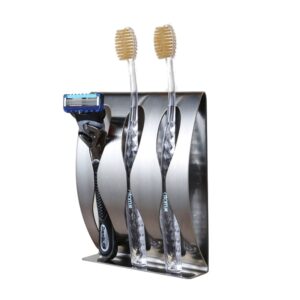
The importance of cleaning your toothbrush holder cannot be overstated. A toothbrush holder is a crucial tool in maintaining good oral hygiene by keeping your toothbrush clean and dry when not in use. However, if not cleaned and maintained properly, a toothbrush holder can quickly become a breeding ground for bacteria, fungi, and other microorganisms that can cause infections and illnesses.
The Risks of Not Cleaning Your Toothbrush Holder
When you brush your teeth, your toothbrush can become contaminated with bacteria and other microorganisms from your mouth. If you place that contaminated toothbrush back into a dirty toothbrush holder, those microorganisms can multiply and spread, leading to potentially harmful consequences.
One of the most common bacteria found on toothbrushes is Streptococcus mutans, which is responsible for tooth decay. Another common bacterium found on toothbrushes is Staphylococcus aureus, which can cause skin infections.
In addition to bacteria, toothbrush holders can also harbor fungi, mold, and other harmful microorganisms. Exposure to these microorganisms can lead to infections, illness, and other health problems.
The importance of cleaning your toothbrush holder cannot be overstated. By properly cleaning and maintaining your toothbrush holder, you can help to prevent the spread of harmful microorganisms and maintain good oral hygiene.
How to Clean and Maintain Your Toothbrush Holder
Cleaning and maintaining your toothbrush holder is relatively easy and can help to prevent the spread of harmful microorganisms. Here are some key steps to follow:
Step 1: Remove All Toothbrushes
Before cleaning your toothbrush holder, remove all toothbrushes from the holder. This will allow you to thoroughly clean and sanitize the holder without any obstructions.
Step 2: Wash with Soap and Water
Once all toothbrushes have been removed, wash the toothbrush holder with soap and water. Use a soft-bristled brush or sponge to scrub the inside and outside of the holder. Pay special attention to any crevices or hard-to-reach areas where bacteria and germs may be hiding.
Step 3: Rinse Thoroughly
After washing the toothbrush holder with soap and water, rinse it thoroughly with warm water. Make sure to remove all soap residue and debris from the holder.
Step 4: Sanitize with Vinegar
To effectively kill bacteria and germs, it is important to sanitize your toothbrush holder regularly. One effective and natural way to do this is to use vinegar.
Fill a bowl with equal parts vinegar and water, and soak the toothbrush holder in the solution for at least 30 minutes. After soaking, rinse the holder thoroughly with warm water.
Step 5: Allow to Dry
Once the toothbrush holder has been washed, rinsed, and sanitized, allow it to dry completely before replacing the toothbrushes. Damp or wet toothbrush holders can promote the growth of bacteria and mold.
It is best to air-dry the holder by placing it in a well-ventilated area, or by using a towel to dry it off.
Additional Tips for Maintaining Your Toothbrush Holder
In addition to regular cleaning and sanitizing, there are several other steps you can take to maintain your toothbrush holder and promote good oral hygiene.
Replace Your Toothbrush Holder Regularly
Even with regular cleaning and maintenance, toothbrush holders can become worn, cracked, or stained over time. It is important to replace your toothbrush holder regularly to ensure that it remains clean and hygienic.
If you notice any signs of wear or damage to your toothbrush holder, it is best to replace it immediately. A damaged toothbrush holder can harbor bacteria and germs, which can lead to oral health problems and illness.
Store Toothbrushes with Bristles Up
When storing toothbrushes in a holder, make sure to store them with the bristles facing up. This will allow them to dry completely and prevent moisture from accumulating in the base of the holder.
Moisture can promote the growth of bacteria and mold, which can lead to oral health problems and illness. By storing your toothbrushes with the bristles facing up, you can ensure that they remain dry and clean between uses.
Avoid Sharing Toothbrush Holders
While it may be convenient to share a toothbrush holder with others, it is best to avoid doing so. Sharing toothbrush holders can lead to the spread of bacteria and germs, and can increase the risk of infection and illness.
If you live with roommates or family members, it is best to use separate toothbrush holders to avoid cross-contamination. This will help to ensure that everyone maintains good oral hygiene and stays healthy.